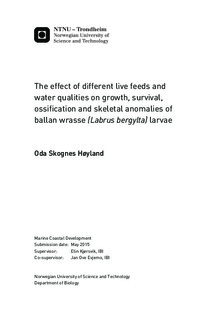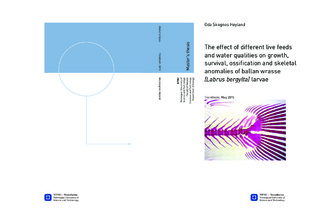| dc.description.abstract | Salmon lice (Lepeophtheirus salmonis) infections is one of the major problems in Atlantic salmon (Salmo salar) aquaculture. This has led to an increasing interest in the cultivation of ballan wrasse (Labrus bergylta), for cleaner fish purposes. The bottleneck in ballan wrasse production is the live feed period, where the main challenges include survival, growth and skeletal anomalies, factors known to be influenced by both dietary and environmental conditions. The dietary requirements for ballan wrasse larvae are generally unknown, but the use of copepods as live feed is widely acknowledged as beneficial for marine pelagic fish larval growth, survival and development, particularly due to their high content of highly saturated fatty acids incorporated in the phospholipid fraction.
This study consists of two start feeding experiments of ballan wrasse; a live feed experiment and a water quality experiment. Larvae from the live feed experiment were fed either enriched rotifers (Brachionus plicatilis) followed by enriched Artemia franciscana, or cultivated copepods (Acartia tonsa) of increasing sizes until 45 days post hatch (dph). Larvae from the water quality experiment were reared in flow-through systems including a regular biofilter. One treatment received microbially matured water conditioned to the carrying capacity (CC) of the larval rearing tanks, to minimize the bloom of opportunistic bacteria following the large gap in CC between intake water and tank water. The larvae were fed enriched rotifers and Artemia until 41 dph, and formulated feed until 70 dph. One additional group was fed 50 % rotifers and 50 % preserved copepods (Planktonic) during the rotifer period.
The use of copepods as live feed for ballan wrasse larvae resulted in significantly higher growth throughout the entire live feed experiment, and this was also the case for larvae reared in microbially matured water in the water quality experiment. Larvae reared in microbially matured water showed an unusually high mortality, probably due to an accidental release of H2S. The larvae fed live copepods had a significantly lower occurrence of skeletal anomalies than all other groups of both experiments, indicating that copepods were the optimal feed organisms for the ballan wrasse larvae. No differences in skeletal anomaly occurrence were found when rearing the ballan wrasse in microbially matured water. | |

